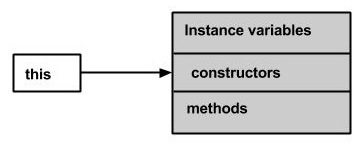Java 方法
Java方法是一组被分组在一起以执行操作的语句。当你调用System.out. println() 方法时,系统实际上会执行多个语句以在控制台上显示一条消息。
现在您将学习如何创建自己的带或不带返回值的方法,如何调用带或不带参数的方法,以及如何在程序设计中应用方法抽象。
创建方法
考虑以下示例以解释方法的语法 −
语法
public static int methodName(int a, int b) {
// body
}
这里,
- public static - 修饰符
-
int - 返回类型
-
methodName - 方法名
-
a, b - 形式参数
-
int a, int b - 参数列表
方法定义由方法头和方法体组成。相同的结构如下所示 –
语法
modifier returnType nameOfMethod (Parameter List) {
// method body
}
上述语法包括以下内容:
- modifier — 定义方法的访问类型,可选择使用。
-
returnType — 方法可能返回一个值。
-
nameOfMethod — 这是方法的名称。方法签名由方法名称和参数列表组成。
-
Parameter List — 参数的列表,包括方法的类型、顺序和数量。这些是可选的,方法可以不含任何参数。
-
method body — 方法体定义了方法执行的具体语句。
示例
以下是上述定义的方法min()的源代码。该方法接受两个参数num1和num2,并返回两者中的最大值。
/** the snippet returns the minimum between two numbers */
public static int minFunction(int n1, int n2) {
int min;
if (n1 > n2)
min = n2;
else
min = n1;
return min;
}
方法调用
为了使用一个方法,需要调用它。一个方法可以通过两种方式进行调用,即返回一个值或者不返回任何值(没有返回值)。
方法调用的过程很简单。当程序调用一个方法时,程序控制权会转移到被调用的方法中。被调用的方法在满足以下两个条件时将控制权返回给调用者:
- 执行了return语句。
- 达到了方法结尾的闭合括号。
返回void的方法被认为是对一个语句的调用。让我们来看一个示例:
System.out.println("This is tutorialspoint.com!");
返回值的方法可以通过以下示例来理解:
int result = sum(6, 9);
以下是一个示例,演示如何定义一个方法以及如何调用它:
示例
public class ExampleMinNumber {
public static void main(String[] args) {
int a = 11;
int b = 6;
int c = minFunction(a, b);
System.out.println("Minimum Value = " + c);
}
/** returns the minimum of two numbers */
public static int minFunction(int n1, int n2) {
int min;
if (n1 > n2)
min = n2;
else
min = n1;
return min;
}
}
这将产生以下结果−
输出
Minimum value = 6
void关键字
void关键字允许我们创建不返回值的方法。在下面的示例中,我们考虑一个void方法methodRankPoints。这个方法是一个void方法,不返回任何值。调用void方法必须是一个语句,即methodRankPoints(255.7);。它是一个以分号结束的Java语句,如下例所示。
示例
public class ExampleVoid {
public static void main(String[] args) {
methodRankPoints(255.7);
}
public static void methodRankPoints(double points) {
if (points >= 202.5) {
System.out.println("Rank:A1");
}else if (points >= 122.4) {
System.out.println("Rank:A2");
}else {
System.out.println("Rank:A3");
}
}
}
这将产生以下结果-
输出
Rank:A1
按值传递参数
在调用过程中,需要传递参数。这些参数应该按照方法规范中对应的参数顺序传递。参数可以按值传递或按引用传递。
按值传递参数意味着调用一个带有参数的方法。通过此方式,参数的值被传递给参数。
示例
以下程序示例展示了按值传递参数的示例。即使在方法调用后,参数的值仍然保持不变。
public class swappingExample {
public static void main(String[] args) {
int a = 30;
int b = 45;
System.out.println("Before swapping, a = " + a + " and b = " + b);
// Invoke the swap method
swapFunction(a, b);
System.out.println("\n**Now, Before and After swapping values will be same here**:");
System.out.println("After swapping, a = " + a + " and b is " + b);
}
public static void swapFunction(int a, int b) {
System.out.println("Before swapping(Inside), a = " + a + " b = " + b);
// Swap n1 with n2
int c = a;
a = b;
b = c;
System.out.println("After swapping(Inside), a = " + a + " b = " + b);
}
}
这将产生以下结果 –
输出
Before swapping, a = 30 and b = 45
Before swapping(Inside), a = 30 b = 45
After swapping(Inside), a = 45 b = 30
**Now, Before and After swapping values will be same here**:
After swapping, a = 30 and b is 45
方法重载
当一个类有两个或更多同名但参数不同的方法时,这被称为方法重载。它与重写不同。在重写中,一个方法具有相同的方法名、类型、参数数量等。
让我们考虑之前讨论的找到整数类型最小数字的示例。假设我们想找到双精度类型的最小数字。那么就会引入重载的概念,创建两个或更多同名但参数不同的方法。
以下的示例解释了这个概念:
示例
public class ExampleOverloading {
public static void main(String[] args) {
int a = 11;
int b = 6;
double c = 7.3;
double d = 9.4;
int result1 = minFunction(a, b);
// same function name with different parameters
double result2 = minFunction(c, d);
System.out.println("Minimum Value = " + result1);
System.out.println("Minimum Value = " + result2);
}
// for integer
public static int minFunction(int n1, int n2) {
int min;
if (n1 > n2)
min = n2;
else
min = n1;
return min;
}
// for double
public static double minFunction(double n1, double n2) {
double min;
if (n1 > n2)
min = n2;
else
min = n1;
return min;
}
}
这将产生以下结果−
输出
Minimum Value = 6
Minimum Value = 7.3
方法的重载使程序更易读。此处,通过相同的名称但具有不同参数的两个方法给出。整数和双精度类型的最小数是结果。
使用命令行参数
有时你希望在运行程序时传递一些信息。这可以通过向main()传递命令行参数来实现。
命令行参数是直接跟随程序名称执行命令时的信息。在Java程序中访问命令行参数非常容易。它们以字符串形式存储在传递给main()的String数组中。
示例
以下程序显示调用它时使用的所有命令行参数 –
public class CommandLine {
public static void main(String args[]) {
for(int i = 0; i<args.length; i++) {
System.out.println("args[" + i + "]: " + args[i]);
}
}
}
试着按照这里展示的方式执行这个程序-
$java CommandLine this is a command line 200 -100
这将产生以下结果−
输出
args[0]: this
args[1]: is
args[2]: a
args[3]: command
args[4]: line
args[5]: 200
args[6]: -100
this关键字
this 是Java中的一个关键字,用作对当前类的对象的引用,在实例方法或构造函数中使用。使用 this 可以引用类的成员,如构造函数、变量和方法。
注意 - 关键字 this 仅在实例方法或构造函数中使用。

通常,关键字 this 用于以下目的−
- 如果在构造函数或方法中具有相同的名称,区分实例变量和局部变量。
class Student {
int age;
Student(int age) {
this.age = age;
}
}
- 在一个类中,从另一个类中调用一种类型的构造函数(参数化构造函数或默认构造函数)。这被称为显式构造函数调用。
class Student {
int age
Student() {
this(20);
}
Student(int age) {
this.age = age;
}
}
示例
这是一个使用 this 关键字访问类成员的示例。将以下程序复制并粘贴到一个名为 This_Example.java 的文件中。
public class This_Example {
// Instance variable num
int num = 10;
This_Example() {
System.out.println("This is an example program on keyword this");
}
This_Example(int num) {
// Invoking the default constructor
this();
// Assigning the local variable num to the instance variable num
this.num = num;
}
public void greet() {
System.out.println("Hi Welcome to Tutorialspoint");
}
public void print() {
// Local variable num
int num = 20;
// Printing the local variable
System.out.println("value of local variable num is : "+num);
// Printing the instance variable
System.out.println("value of instance variable num is : "+this.num);
// Invoking the greet method of a class
this.greet();
}
public static void main(String[] args) {
// Instantiating the class
This_Example obj1 = new This_Example();
// Invoking the print method
obj1.print();
// Passing a new value to the num variable through parametrized constructor
This_Example obj2 = new This_Example(30);
// Invoking the print method again
obj2.print();
}
}
这将产生以下结果:
输出
This is an example program on keyword this
value of local variable num is : 20
value of instance variable num is : 10
Hi Welcome to Tutorialspoint
This is an example program on keyword this
value of local variable num is : 20
value of instance variable num is : 30
Hi Welcome to Tutorialspoint
可变参数(var-args)
JDK 1.5 允许您向方法传递相同类型的可变数量的参数。方法中的参数声明如下:
typeName... parameterName
在方法声明中,您需要指定类型,后面跟着省略号(…)。在一个方法中只能指定一个可变长度的参数,并且这个参数必须是最后一个参数。任何常规参数都必须在它之前。
示例
public class VarargsDemo {
public static void main(String args[]) {
// Call method with variable args
printMax(34, 3, 3, 2, 56.5);
printMax(new double[]{1, 2, 3});
}
public static void printMax( double... numbers) {
if (numbers.length == 0) {
System.out.println("No argument passed");
return;
}
double result = numbers[0];
for (int i = 1; i < numbers.length; i++)
if (numbers[i] > result)
result = numbers[i];
System.out.println("The max value is " + result);
}
}
此操作将产生以下结果−
输出
The max value is 56.5
The max value is 3.0
finalize() 方法
可以定义一个方法,该方法将在对象即将被垃圾收集器最终销毁之前被调用。该方法被称为 finalize() ,可用于确保对象的干净终止。
例如,您可以使用finalize() 方法确保该对象拥有的打开文件被关闭。
要向类添加 finalizer,只需定义 finalize() 方法。Java运行时在准备回收该类的对象时调用该方法。
在 finalize() 方法内部,您将指定在销毁对象之前必须执行的操作。
finalize() 方法的一般形式如下:
protected void finalize( ) {
// finalization code here
}
在这里,关键字protected是一个限定符,防止代码定义在类外部的地方访问finalize()。
这意味着您无法知道何时甚至是是否会执行finalize()。例如,如果您的程序在垃圾回收发生之前结束,finalize()将不会执行。
 极客教程
极客教程